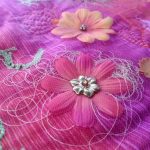There are times when you want to add a bit of texture and fun to a project, but you may not be quite sure what to do. Think about encasing something under tulle, which serves to hold it in place and protect the addition at the same time. What to encase? Depending on the project […]
Tackling Tulle
Whether you’re making a flirty tutu, a long flowing wedding veil or decorating for a bridal shower, it’s likely some tulle will be involved in the process. Like its netting cousin, tulle is an openwork fabric sporting allover holes for a transparent look. Netting has larger holes than tulle and it’s usually stiffer. Both are […]







